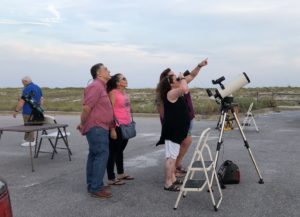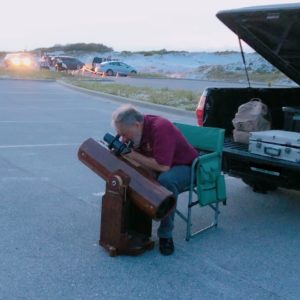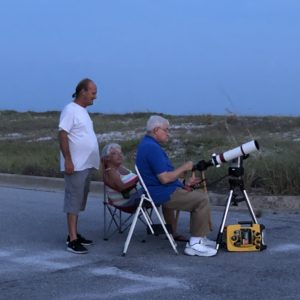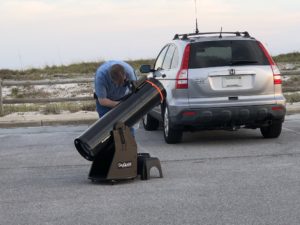The NWFAA rolled the dice and decided to go ahead with our Henderson Beach star gaze even though it was pretty cloudy. By the time the solar telescopes were set up the skies were somewhat clear. The few guests who braved the weather and came early to view the Sun did not have to wait long for a blocking cloud to move out of the way. Unfortunately, they didn’t get to see a whole lot. The Sun did not have any sunspots but there was one easy to see filament and one small very thin loop prominence visible in H-alpha light.
Since there were no sunspots, Dennis pointed his Maksutov at the planet Venus well before the Sun set. The partially lit planet made a fine picture in the daytime sky.
Luckily, the lower the Sun got to the horizon, the clearer the sky became. As the Sun set into clouds on the western horizon, Tom reconfigured his scope to visible light and brought Jupiter into view. The view was very low contrast at first but as the skies darkened the Galilean moons popped into view one by one.
By the time the Sun set we had a great turnout of NWFAA members:
- Frank Atchison
- Dave Halupowski & Kennedy Odom
- Tom Haugh
- Dennis & Marietta Hausch
- Scott Morgan
In addition to Venus and Jupiter our guest observers were treated to views of the planets Saturn and Mars. As usual Saturn was the highlight but Mars is starting to become a little more interesting. It has finally started to show some surface markings as the dust storm has started to wind down. We also viewed Vega and Antares; both bright enough to pierce the state park’s light pollution. Frank attached a DSLR to his scope and showed some star clusters via the camera’s preview screen. Scott tried the ring nebula with his newly acquired 10″ Dobsonian but the nebula was barely detectable through the haze and sky glow.
Finally about 2130 the last guest observer left and at the same time some small clouds started to encroach from the north. We called it a night, packed up and headed home.



